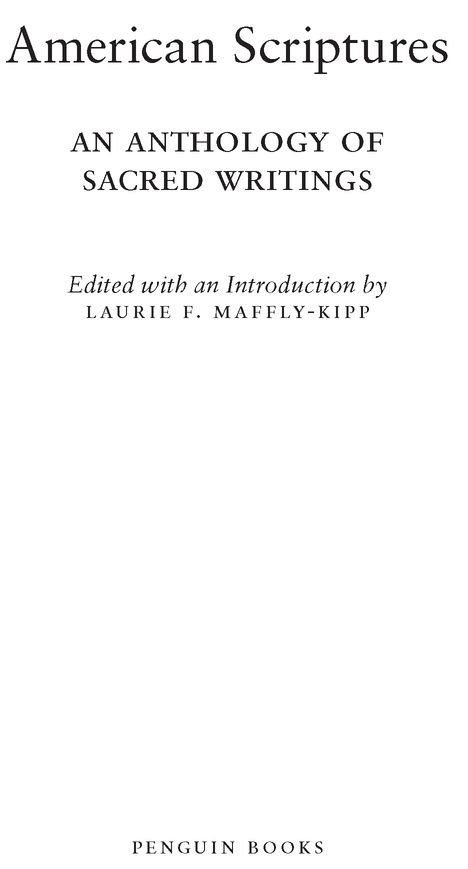Table of Contents
PENGUIN

CLASSICS
AMERICAN SCRIPTURES
LAURIE F. MAFFLY-KIPP is Professor and Chair of the Department of Religious Studies at the University of North Carolina at Chapel Hill.
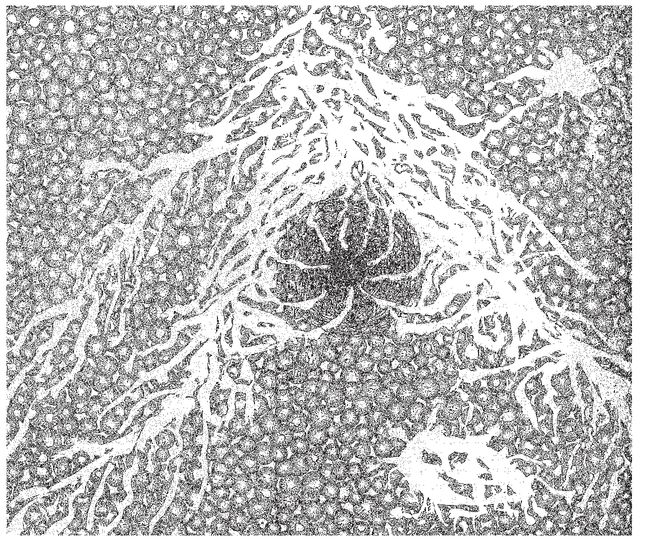
Showing the earth in the thirty-second year of the kosmon era. Jehovih said: When the world approacheth danha in Sabea, the nations shall be quickened with new light; for kosmon cometh out of the midst. And My etherean hosts shall press upon the understanding of men, and they shall fill all the nations and kingdoms with new discoveries and inventions and books of learning. And men shall be conceited of themselves above all the ages past, and they shall deny Me and quarrel with My name, and cast Me out. But I will come upon them as a Father, in love and mercy: and My hosts of heaven shall cause babes and fools to confound the wise, by signs and miracles. My hosts from heaven shall cause chairs to speak; and inanimate things to walk, and dance. The dead shall reappear to the living, and talk with them face to face, and eat and drink, and prove themselves to the children of earth, and make My kingdoms known. Yea, they shall encompass the whole earth around about with signs and wonders, and set at naught the philosophy of men and the idolatries of the ancients. For both, the living and dead, shall know that I, Jehovih, live and reign over heaven and earth. This shall be a new era, and it shall be called, kosmon, because it embraceth the present and all the past. Then will I reveal Myself; and they that deny Me shall accept Me: of their own accord will they put away their Lords and their Gods and their Saviors; nor shall they more have idols of Me, either on earth or in heaven, for I am sufficient unto all.
Arc of Kosmon, OAHSPE, p. 728
Introduction
Many Americans are, and always have been, fascinated with the Bible. But the interest extends far beyond simply reading the texts. The popularity in recent decades of Elaine Pagels Gnostic Gospels (1979), the growth industry surrounding work on lost and forgotten Christian manuscripts, and the fascination evidenced about the possibility of lost traditions broached in the novel The Da Vinci Code (2003) suggest an enduring preoccupation with filling out, correcting, or extending the stories and teachings of the Bible. Thomas Carlyle once suggested that Every man that writes is writing a new Bible, or a new Apocrypha, and there is an important truth contained in his words: Many Christians, especially those in the United States, view their sacred texts not simply as vessels of divine revelation but as occasions for devotional creativity. They improvise and engage with religious texts in many ways, transforming the very objects of their devotion in the process.
This tendency to engage scripture through emendation and addition was especially apparent in the United States after the American Revolution, when the promise of a new nation smiled upon by divine providence gripped Euro-American Protestants and unleashed religious energies in unprecedented ways. In the heady and tumultuous decades of the early nineteenth century, many Americans sought religious truths that would help them make sense of this new republic and allow them to communicate their understandings to others. Sacred texts that would both connect them to their (predominantly Christian) past and take them into an uncertain future proved a remarkably potent way of expressing and transforming faith and of wedding the twin imperatives of stability and flexibility. Writings as diverse as the Book of Mormon (1830), the Shakers Holy, Sacred and Divine Roll and Book (1843), James Colin Brewsters A Warning to the Latter Day Saints (1845), Andrew Jackson Daviss Principles of Nature (1847), Ellen Whites The Great Controversy (1888), Lorenzo Dow Blacksons The Rise and Progress of the Kingdoms of Light and Darkness (1867), Mary Baker Eddys Science and Health with Key to the Scriptures (1875), and John Ballou Newbroughs OAHSPE: A New Bible in the Words of Jehovih and his Angel Embassadors (1882) all claimed to extend or complete the promises of the Bible; many of these new scriptures caught the attention of growing numbers of believers willing to commit themselves to the truth of their teachings. Authors including Thomas Jefferson and Elizabeth Cady Stanton rewrote the scriptures they already had to conform to changing religious views.
By the mid-nineteenth century, readers of the Bible also began to question the veracity and completeness of the life of Jesus as it was presented in the four canonized Christian Gospels. In response, ministers, visionaries, anonymous authors, and even dentists began to produce new gospels, claiming a variety of sacred origins for their works. The results of their labors included Alexander Smyth, Occult Life of Jesus of Nazareth (1864); Olive G. Pettis, the Autobiography by Jesus of Nazareth (1870); Rev. W. D. Mahan, The Archko Volume (1887); Nicolas Notovitch, The Unknown Life of Jesus Christ (1890); and Levi Dowling, The Aquarian Gospel of Jesus the Christ (1907). Indeed, this list does not exhaust the list of American Scriptures that one might consult from this intensely creative era.
This volume introduces fifteen of these texts written between 1794 and 1907. These works are compelling and historically valuable because they represent the wide range of popular writings catalyzed by the democratization of religious life in the decades after the American Revolution, an era when men and women, African Americans and whites, and elites and nonelites felt empowered to enact and even design their own scriptural traditions. The texts they produced demonstrate that the hunger for theological improvisation ran deep; rather than listening solely to the words of ministers and scholars, or simply absorbing the teachings of charismatic revivalist preachers, these Americans and their followers were ready, quite literally, to take the Bible into their own hands. As the bestselling book in the nation by the 1820s, the Bible thereby stimulated the composition of other kinds of scriptures.
Though clearly of interest to scholars of the Christian tradition, the importance of these works extends beyond and allows us to question doctrinal boundaries. These texts suggest new ways of thinking about the varieties of Christianity in the United States and its connections to other religious movements. Many of these sources, such as the Book of Mormon and Science and Health, formed the basis for the collective worship of new faith communities on the American scene. Other texts moved away from Christianity in ways that are perhaps not so readily apparent (sometimes because their lineage has been effaced by orthodox Christians): Lorenzo Dow Blacksons The Rise and Progress of the Kingdoms of Light and Darkness (1867), a book written right after the Civil War by an unschooled member of the African Union Church, may be considered an odd or even idiosyncratic apocalyptic text. But it dramatizes racial themes and perspectives that infused the writings of other African American Protestants at the time. Similarly,


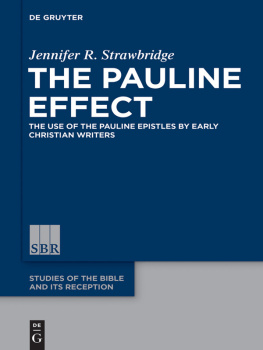


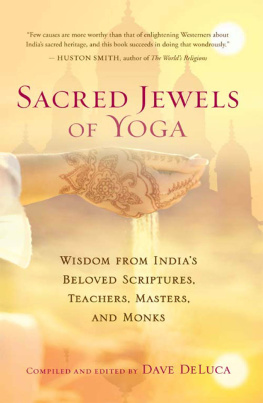
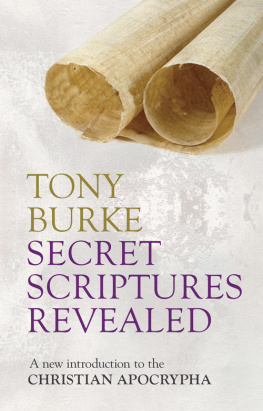

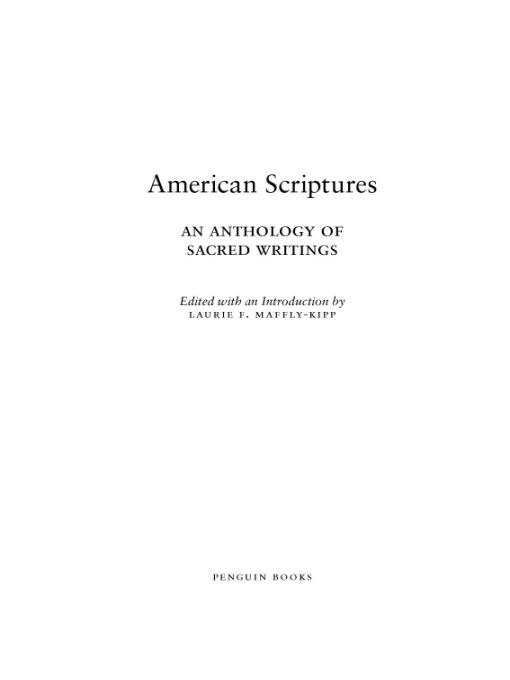
 CLASSICS
CLASSICS
